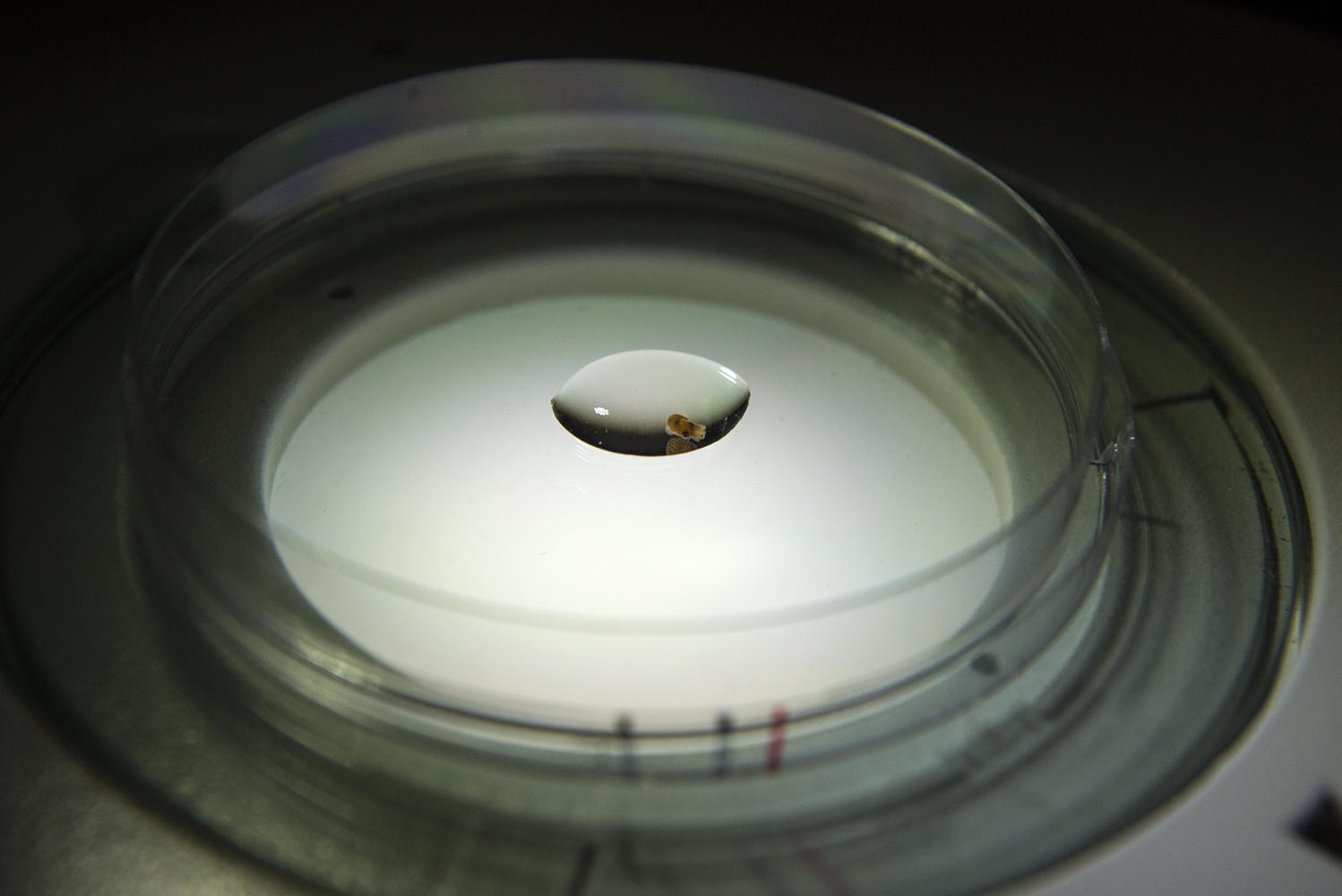Microbiology students studying bioluminescent squid to understand immune system
Kate Shields, a senior microbiology student from Vandalia removes the ink sack from a baby squid Thursday, Sept. 21, 2017 at a laboratory in Lindegren Hall. (Dylan Nelson | @Dylan_Nelson99)
September 25, 2017
Hunting for glow-in-the-dark squid in the middle of the night on the coast of Hawaii might not be how most students on campus spent their summers, but for some microbiology students it was a chance to further their research.
Kate Shields, a senior from Vandalia, spent 10 days this summer on the beaches of Oahu searching for the Hawaiian bobtail squid, which at its largest is about three inches long.
“I was on a plane for roughly 14, 15 hours,” Shields said. “Then we went squidding that night. It was crazy.”
Advertisement
The species of squid is unique because it forms a symbiotic relationship with a bioluminescent bacteria that mimics the moonlight, but the light is so dim that human eyes can’t register it.
However, microbiology professor Bethany Rader said predators can see them, and the squid use the bacteria to mask a faint shadow cast by moonlight.
By pointing a special organ filled with light-producing bacteria toward the ocean floor, the nocturnal squid are able to mask their shadow and hide from potential threats.

Shields said she and masters microbiology student Katie Melton would go out each night anywhere between dusk and dawn and would wade in the water, hunting for squid.
“Squiding is really an abstract thing to think about until you do it,” Shields said. “You go out in your poncho and a pair of swim tights or leggings and swim shoes. You have a head lamp, you have a flashlight in one hand and a net you’re dragging over your waist. ”
After hours of searching for squid, the pair would find one and scoop it up in the net. Over the course of their time in Hawaii, they found 16 squid.
But Shields said she thinks the squid move offshore in the summer, because an outing in the winter season yielded around 64 squid.
Advertisement*
While the lab doesn’t have any squid right now, Rader said she is planning another catch around November.
The squid live for around three to four months in the lab, and though Rader said they have not raised any offspring bred in the lab, she wants to try.
Shields’ research involves a two-step process: first where she mutates and studies bacteria, followed by inserting that bacteria into the squids’ light organs.
Shields said the process of creating a mutant bacterium took around seven months.
“We use mutants to see how they react against wild type, which is something that acts as it is in nature,” she said. “If we want to see what a certain protein does or what the absence of a certain protein does, we make a mutant where we kick out that protein so everything about that cell is exactly the same as the wild type cell in nature except for one thing.”
The squid are born without the bacteria, but upon hatching, the bacteria colonize in the squid’s light organ for the rest of their life. Rader said the squid “sneeze” every morning and expel around 95 percent of the bacteria, which will build back up by night.
Rader, who has been studying the squid since 2007, said the bacteria-squid relationship can be useful in understanding how humans form relationships with many bacteria, most commonly found in the gut.

According the Nature, there are about as many bacterial cells as there are human cells in the body, which can make for a lot of interactions. Rader said the Hawaiian bobtail squid model is one of the easiest to study because it’s a simple relationship with only one species of bacteria.
“The better we understand how we form these beneficial relationships with these bacteria, the easier it’s going to be to prevent opportunistic infections,” Shields said.
Inflammatory bowel diseases such as Crohn’s disease and ulcerative colitis commonly infect the intestinal tract. Rader said there’s also been evidence gut bacteria can lead to Type II diabetes and obesity.
Since her research at SIU began, Rader has expanded the project with psychology Professor Michael Hylin, who studies traumatic brain injury by using rats.
“With our squid model, we’re asking how do these things happen,” Rader said. “With our rat model, we’re asking, ‘Can we utilize that knowledge to the betterment of humanity?'”
The two are trying to use a certain gut bacterium called Lactobacillus to treat brain injuries.
“What’s really exciting is when we give these animals Lactobacillus, it decreases the inflammation in the brain at the injury site,” Rader said.
Shields, who has been working with Rader since her freshman year, said she has been with the project since it began at SIU, and by the time she graduates in May, she hopes to cap her research by publishing her findings on the mutants.
“I got really lucky because it was Dr. Rader’s first semester as it was my first semester,” she said. “Getting to see this project come from nothing into something has been incredible.”
Staff writer Cory Ray can be reached at cray@dailyegyptian.com or on Twitter @coryray_de.
To stay up to date with all your southern Illinois news, follow the Daily Egyptian on Facebook and Twitter.
Advertisement








